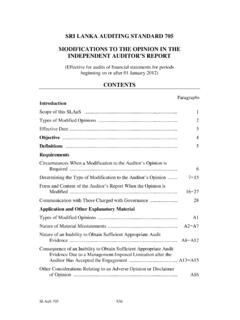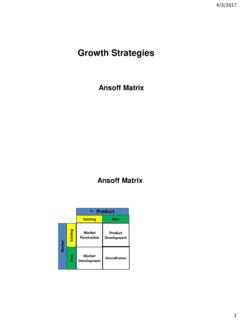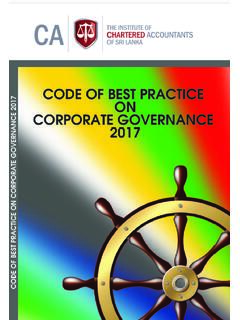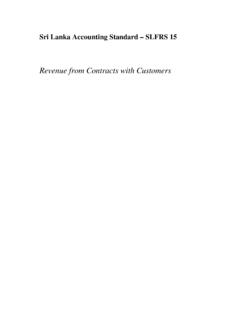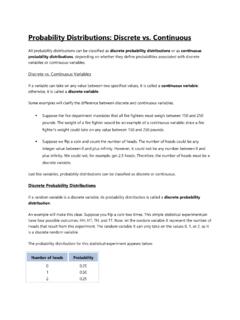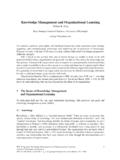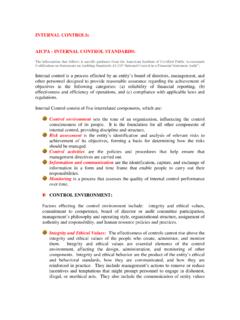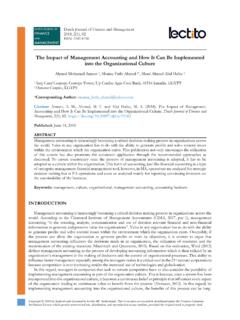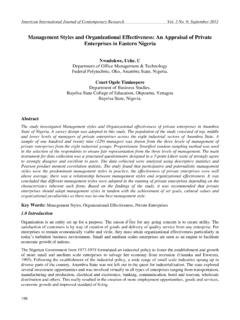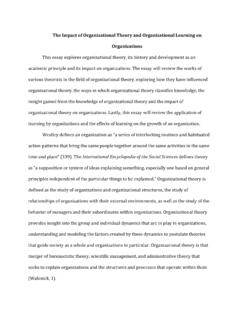Transcription of Introduction to Management Control Systems - CA Sri Lanka
1 Introduction to Management Control SystemsLecture 01By: Kanchan DamithendraBefore We get to know each other!Ground Rules Respect yourself & others Mind your devices Knowledge sharing Don t copy Be creativeCourse Contents (Business Controls & Systems ) Management Control Systems (L1,L2 & L3) Risks faced by organizations (L4 & L5) Risk Management & Internal Controls (L6 & L7) Review & Audit of Control Systems (L8 & L9) Risks & controls in Information Systems (L10 & L11) GROUP PRESENTATIONS (L12)What is Management Control ?DefinitionControlling is the measurement and correction of performance in order to make sure that enterprise objectives and the plans devised to attain them are accomplished(Harold Koontz)Why Management Control ?AGENCY THEORYAGENCY THEORY People are rational People are self interestedWhy Management Control ? of MC Guide employees effectively towards the accomplishment of goalsGoal Congruence-Senior Management wants the organization to attain the organizational goals but the employees are interested in achieving their personal goalsThus the central purpose of the Control system is to make sure that a high level of Goal congruence is implementedOrganizational StructureElements of A detector or sensor to measure what actually happened, such as a balance sheet or income statement.
2 An assessor to determine the significance of what has happened by comparing to a standard or expectation, such as variance analysis and budgeting. An effector a device or feedback system that alters behavior, such as the root-cause analysis used in Balanced Scorecards, to compare budget to actual results and look for changes to continue or to change actions. A communication network to transmit information, includes the computer system and meetingsExample Identify the Detector, Assessor, Effector & Communication system of below Control Assurance system in a manufacturing plantTypes of organizational Strategic ControlWho we are? What we do?Why we exist? Where its heading towards? Management ControlTranslation of strategic goals to business unit objectives, Resource utilization Operational ControlEfficiencies, On time deliveries, Target achievements, Quality production, BudgetsMC & Strategy Management Control , on the other hand, is the process of implementing and evaluating the strategy.
3 A well-defined Management Control system should evaluate both the business-level and corporate-level strategies Corporate strategy deals with the entire company Business level strategy deals with a particular business unitCorporate Strategy FormulationExternal Environment AnalysisPEST Political Economic Sociocultural TechnologicalInternal Environment AnalysisPorter s Five ForcesBusiness Unit Strategies-BCG MatrixPorters Generic StrategiesPorter s Generic Strategy Cost Leadership Differentiation FocusTypes of Controls Formal Control -written, Management -initiated mechanisms that influence the behavior of employees in achieving the organization s goals-Framed by managers Informal Control -unwritten, typically worker-initiated mechanisms that influence thebehavior of individuals or groups in business units-Originate with employees and are affected by general socio-cultural factorsFormal Market?Bank?Informal Controls Self Control Social Controls Cultural ControlsSelf Control Itdealswiththeestablishmentofthepersonal objectivesbytheindividual, sgoalsareincongruencewiththeindividual Social Controls Prevailingsocialperspectivesandpatternso finterpersonalinteractionswithinsubgroup sinthefirm Organization establishes certain standards, monitors conformity with the standard and takes action when deviations occur Social Control arises out of the internalization of values and mutual commitment towards some common goalsCultural Codes of conduct Often these are formal written documents containing the broad statements of corporate values; they can include codes of ethics and mission statements.
4 Group-based rewards Necessary when the actions of a team of workers rather than any individual are key to organizational success. Physical and social arrangements How the office is planned, including floor layout and interior decoration; dress codes and common vocabularies are also important. Intra- organizational transfers Promote identification with the organization as a whole rather than with a specific subunit; ensures that socialization of transferred individuals results in compatible goals and Control Deal specifically with the integrity of internal financial information and the accuracy of financial reports provided to outsiders Cash Control Separation of Duties Documentation Information Security Audits




